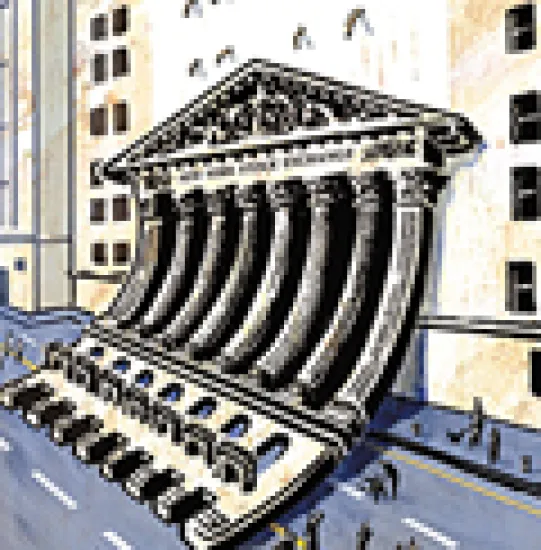The history of finance progresses through different eras, each with its own distinct characteristics. Each age is guided by an ideology that influences fiscal, regulatory and monetary policies. The past quarter of a century has witnessed the triumph of monetarist economics, whose most famous exponent was the late Milton Friedman. In a new book, The New Paradigm for Financial Markets, George Soros argues that the current crisis signals the “end of an era.” The period of financial liberalization and innovation, and of laissez-faire attitudes toward the regulation of capital markets, may be coming to an end. Soros’ thesis, if correct, spells bad news for stock market investors.
The so-called New Era of the 1920s has much in common with developments of recent years. It combined an adherence to laissez-faire economic policies with a belief that the monetary policy of the then–recently established Federal Reserve Board had brought an end to booms and busts. The Fed of the 1920s, like its counterpart today, focused on maintaining stable consumer prices while ignoring strong credit growth and speculative behavior. Inflation was nonexistent and productivity growth strong.
Deposit-taking banks set up securities affiliates to evade regulations and sell stocks and bonds directly to their customers. They also lent heavily to the burgeoning real estate sector. Debt soared as a percentage of national income, and the quick fortunes coined on Wall Street contributed to widening income inequality. This new era of perpetual prosperity was associated with a cult of equities. If stocks could only go up, it seemed sensible to buy them on margin.
The economic collapse that followed the stock market crash in late 1929 revealed the flaws of the New Era. Banks collapsed not just because the Fed allowed deflation to set in. Many, such as the Bank of United States, which failed in December 1930, were heavily exposed to the declining stock and property markets. Wall Street insiders were later excoriated for manipulating the stock markets, for flogging dodgy securities and for a number of other abuses. The central bank, together with the establishment economists who believed the tilting economic ship would right itself without intervention, was discredited. The age of Big Government had arrived.
The policies of Franklin Roosevelt’s New Deal attempted to address capitalism’s failings. The banking system and capital markets were more heavily regulated. Borrowing on margin was limited by law, and commercial banks were kept out of the securities business by the Glass-Steagall Act of 1935. Social inequality was reduced by raising taxes. After 1945 capital controls and tariffs restricted the free flow of money and goods around the world.
The economic catastrophe left individuals and corporations with a fear of debt. This change of attitude is reflected in Freeman Tilden’s A World in Debt (1935), which provides a pathology of the debt disease, or “credit sickness.” The world, he wrote, had entered a “receivership of civilization.” After peaking in the early 1930s, the ratio of private sector debt to GDP fell back to its preboom level and remained at this low point for half a century. Equities, which fell nearly 90 percent from their 1929 peak, were seen as unduly speculative. By the end of the 1930s, even Benjamin Graham, the “father of security analysis,” had lost his faith in stocks.
New eras reflect the belief that the authorities can control the business cycle while simultaneously delivering stable consumer prices. Keynesian demand-management policies in the 1950s proved effective in turning potential depressions into mild recessions. Equity valuations soared. However, the outbreak of stagflation in the mid-1970s undermined investors’ faith in the competence of the Fed. The demise of Keynesianism was accompanied by a declining stock market.
The latest era in the history of finance started with the Reagan-Thatcher “revolution” of the early 1980s and Paul Volcker’s successful battle against inflation. It has combined a number of factors: financial deregulation, the abolition of capital controls, globalization, lower taxes, rapid debt growth and increasing leverage. Financial innovation has been extraordinary. Monetarist economists have peopled the world’s central banks. Like their forebears in the ’20s, they have focused on controlling consumer prices and have ignored asset price inflation. During his tenure at the Fed, Alan Greenspan was credited with successfully curtailing recessions and averting financial crises.
The newfound confidence in the abilities of monetary policymakers was reflected both in the “New Paradigm” of the 1990s, which argued for higher equity valuations on the grounds that stocks were less risky now that the business cycle had been tamed, and later in the “Great Moderation” of this decade, which was used to justify ever-increasing levels of debt and financial leverage. Unfortunately, the New Paradigm gave way to irrational exuberance and a stock market bubble, while the Great Moderation was accompanied by a real estate bubble and the proliferation of increasingly complex debt securities based on risk models that turned out to be fundamentally flawed.
In his book Soros assumes the authorities in Washington have lost control over events. There’s some evidence for this. Despite the frantic efforts of Ben Bernanke’s Fed, securitizations have dried up, credit growth is slowing, and lenders are tightening. “We are in a period of forced deleveraging and the destruction of financial wealth,” writes Soros.
Low interest rates haven’t revived the ailing U.S. housing market. Now that they can no longer use their homes as ATM machines, U.S. consumers face the dreadful prospect of living within their means. Low rates are also creating unexpected problems. A bubble has rapidly inflated in the commodity markets. Unlike the other bubbles of the past ten years, which at least created the illusion of prosperity, higher energy and food prices make people feel immediately worse off. They are also creating a global political crisis, from Egypt to Indonesia. The Fed’s ability to maintain low interest rates is further constrained by the increasing reluctance of foreign investors to hold dollar-denominated financial assets.
If we have come to the end of one era of financial capitalism, what might the next one look like? Soros suggests there will be a move away from what he calls “market fundamentalism,” toward greater regulation of the financial system. Monetarism may have had its day. Soros hopes its replacement will incorporate his own theory of “reflexivity,” which views the financial markets as fundamentally unstable. In the future the authorities will be forced to respond to asset price bubbles. Just as the Great Depression brought about the demise of the gold standard, Soros believes the current crisis heralds the end of the dollar as the international reserve currency.
All this is simply speculation. Historical precedent is more instructive in one respect. If the Fed loses both its grip on inflation and its ability to drag the economy out of recession, investors will demand a higher risk premium for stocks. That’s what happened in the 1930s and 1970s. Such an outcome isn’t currently priced into the market.
Edward Chancellor is the author of Devil Take the Hindmost and a senior member of GMO’s asset allocation team.






